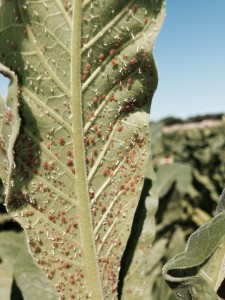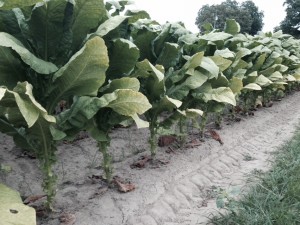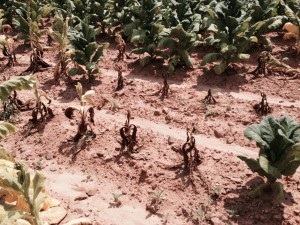Tobacco Insect Scouting Report, July 31 2015
go.ncsu.edu/readext?368031
en Español / em Português
El inglés es el idioma de control de esta página. En la medida en que haya algún conflicto entre la traducción al inglés y la traducción, el inglés prevalece.
Al hacer clic en el enlace de traducción se activa un servicio de traducción gratuito para convertir la página al español. Al igual que con cualquier traducción por Internet, la conversión no es sensible al contexto y puede que no traduzca el texto en su significado original. NC State Extension no garantiza la exactitud del texto traducido. Por favor, tenga en cuenta que algunas aplicaciones y/o servicios pueden no funcionar como se espera cuando se traducen.
Português
Inglês é o idioma de controle desta página. Na medida que haja algum conflito entre o texto original em Inglês e a tradução, o Inglês prevalece.
Ao clicar no link de tradução, um serviço gratuito de tradução será ativado para converter a página para o Português. Como em qualquer tradução pela internet, a conversão não é sensivel ao contexto e pode não ocorrer a tradução para o significado orginal. O serviço de Extensão da Carolina do Norte (NC State Extension) não garante a exatidão do texto traduzido. Por favor, observe que algumas funções ou serviços podem não funcionar como esperado após a tradução.
English
English is the controlling language of this page. To the extent there is any conflict between the English text and the translation, English controls.
Clicking on the translation link activates a free translation service to convert the page to Spanish. As with any Internet translation, the conversion is not context-sensitive and may not translate the text to its original meaning. NC State Extension does not guarantee the accuracy of the translated text. Please note that some applications and/or services may not function as expected when translated.
Collapse ▲Similar to recent weeks, we are still in a bit of a midsummer lull for pest pressure. However, we still have weeks to go, and a lot can change in that time. Below are a few points of interest from the week.
Although we haven’t seen aphids at any of our on-farm sites, we are seeing heavy infestations at the Oxford Tobacco Research Station. Our project there focuses on tobacco production for use in biofuel manufacture, and this week we had to made a foliar treatment of Admire Pro to help control these aphids. The active ingredients used on hornworms and budworms are not as effective for aphids, so selecting the proper chemical for treatment is very important.
Several sites have already started harvesting and are done with the first priming. We collect leaves by hand from 100 plants throughout the field to measure differences in green leaf weight between our IPM and standard fields. The goal is to see if fewer pesticide applications, characteristic of an IPM program, will have an effect on yield. We also collect samples to determine differences in pesticide residues.
Lastly, I wanted to show an image of potentially diseased plants. It may be important for a grower to investigate what pathogens are present in the field now to help with identification or plant rotation schedules in the future. Better, more detailed information on a given field and it’s history can help to plan rotations such that pest pressure and disease can be limited as much as possible. This may also help to reduce the need for preventative or remedial chemical treatments.
Eastern 1
Scouting Report, Eastern 1 – Grower Standard Field
| Insect observation | No. aphid infested plants | Flea beetles per plant | Percent tobacco budworm infested plants | Hornworms per plant | Percent cutworm damaged plants | Other insects |
| Treatment needed? | 0 – No treatment | 1.12 flea beetles/plant– No treatment | 6% infested – No treatment | 12% – Req treatment | 0 – No treatment |
Scouting Report, Eastern 1 – IPM Field
| Insect observation | No. aphid infested plants | Flea beetles per plant | Percent tobacco budworm infested plants | Hornworms per plant | Percent cutworm damaged plants | Other insects |
| Treatment needed? | 0 – No treatment | 0.87 flea beetles/plant– No treatment | 6% infested – No treatment | 6% – No treatment | 0 – No treatment |
Eastern 2
Scouting Report, Eastern 2 – Grower Standard Field
| Insect observation | No. aphid infested plants | Flea beetles per plant | Percent tobacco budworm infested plants | Hornworms per plant | Percent cutworm damaged plants | Other insects |
| Treatment needed? | 0 – No treatment | 0.18 flea beetles/plant– No treatment | 0% infested – No treatment | 0 – No treatment | 0 – No treatment |
Scouting Report, Eastern 2 – IPM Field
| Insect observation | No. aphid infested plants | Flea beetles per plant | Percent tobacco budworm infested plants | Hornworms per plant | Percent cutworm damaged plants | Other insects |
| Treatment needed? | 0 – No treatment | 0.26 flea beetles/plant– No treatment | 0% infested – No treatment | 0 – No treatment | 0 – No treatment |
Eastern 3
Scouting Report, Eastern 3 – Grower Standard Field
| Insect observation | No. aphid infested plants | Flea beetles per plant | Percent tobacco budworm infested plants | Hornworms per plant | Percent cutworm damaged plants | Other insects |
| Treatment needed? | 0 – No treatment | 0.96 flea beetles/plant– No treatment | 0% infested – No treatment | 10% – Req treatment | 0 – No treatment |
Scouting Report, Eastern 3 – IPM Field
| Insect observation | No. aphid infested plants | Flea beetles per plant | Percent tobacco budworm infested plants | Hornworms per plant | Percent cutworm damaged plants | Other insects |
| Treatment needed? | 0 – No treatment | 1.12 flea beetles/plant– No treatment | 0% infested – No treatment | 0% – No treatment | 0 – No treatment |
_________________________________________________________________
Piedmont 1
Scouting Report, Piedmont 1 – Grower Standard Field
| Insect observation | No. aphid infested plants | Flea beetles per plant | Percent tobacco budworm infested plants | Hornworms per plant | Percent cutworm damaged plants | Other insects |
| Treatment needed? | 0 – No treatment | 1.3 flea beetles/plant– No treatment | 0% infested – No treatment | 0 – No treatment | 0 – No treatment |
Scouting Report, Piedmont 1 – IPM Field
| Insect observation | No. aphid infested plants | Flea beetles per plant | Percent tobacco budworm infested plants | Hornworms per plant | Percent cutworm damaged plants | Other insects |
| Treatment needed? | 0 – No treatment | 3.2 flea beetles/plant– No treatment | 0% infested – No treatment | 4% – No treatment | 0 – No treatment |
Piedmont 2
Scouting Report, Piedmont 2 – Grower Standard Field
| Insect observation | No. aphid infested plants | Flea beetles per plant | Percent tobacco budworm infested plants | Hornworms per plant | Percent cutworm damaged plants | Other insects |
| Treatment needed? | 0 – No treatment | 0.64 flea beetles/plant– No treatment | 4% infested – No treatment | 8% – No treatment | 0 – No treatment |
Scouting Report, Piedmont 2 – IPM Field
| Insect observation | No. aphid infested plants | Flea beetles per plant | Percent tobacco budworm infested plants | Hornworms per plant | Percent cutworm damaged plants | Other insects |
| Treatment needed? | 0 – No treatment | 0.44 flea beetles/plant– No treatment | 4% infested – No treatment | 2% – No treatment | 0 – No treatment |
Piedmont 3
Scouting Report, Piedmont 3– Grower Standard Field
| Insect observation | No. aphid infested plants | Flea beetles per plant | Percent tobacco budworm infested plants | Hornworms per plant | Percent cutworm damaged plants | Other insects |
| Treatment needed? | 0 – No treatment | 0.32 flea beetles/plant– No treatment | 0% infested – No treatment | 2% – No treatment | 0 – No treatment |
Scouting Report, Piedmont 3 – IPM Field
| Insect observation | No. aphid infested plants | Flea beetles per plant | Percent tobacco budworm infested plants | Hornworms per plant | Percent cutworm damaged plants | Other insects |
| Treatment needed? | 0 – No treatment | 0.67 flea beetles/plant– No treatment | 0% infested – No treatment | 3% – No treatment | 0 – No treatment |
More information
Tobacco insect scouting methods – Tobacco Growers Information Portal





